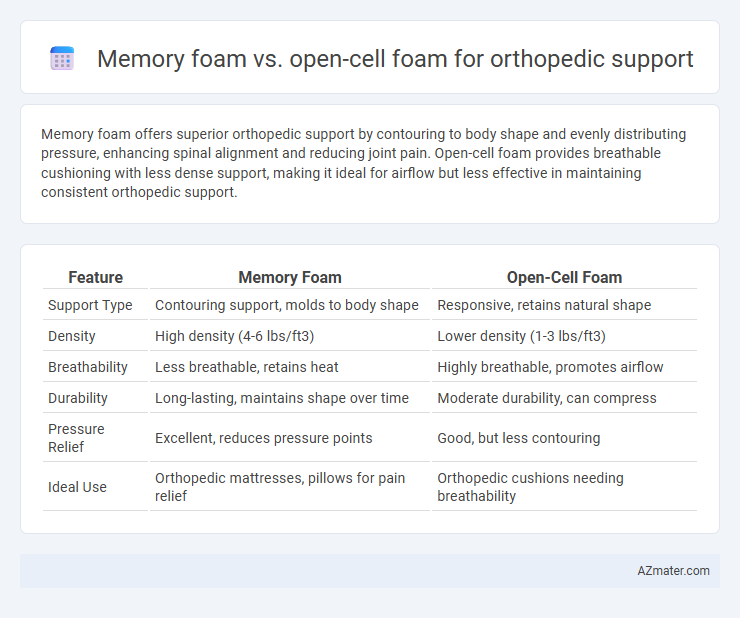Memory foam offers superior orthopedic support by contouring to body shape and evenly distributing pressure, enhancing spinal alignment and reducing joint pain. Open-cell foam provides breathable cushioning with less dense support, making it ideal for airflow but less effective in maintaining consistent orthopedic support.
Table of Comparison
| Feature | Memory Foam | Open-Cell Foam |
|---|---|---|
| Support Type | Contouring support, molds to body shape | Responsive, retains natural shape |
| Density | High density (4-6 lbs/ft3) | Lower density (1-3 lbs/ft3) |
| Breathability | Less breathable, retains heat | Highly breathable, promotes airflow |
| Durability | Long-lasting, maintains shape over time | Moderate durability, can compress |
| Pressure Relief | Excellent, reduces pressure points | Good, but less contouring |
| Ideal Use | Orthopedic mattresses, pillows for pain relief | Orthopedic cushions needing breathability |
Introduction to Orthopedic Support Foams
Orthopedic support foams, including memory foam and open-cell foam, are engineered to provide enhanced pressure relief and spinal alignment. Memory foam features viscoelastic properties that contour closely to the body's shape, offering superior support and reducing pressure points. Open-cell foam boasts a breathable structure that promotes airflow and durability while maintaining sufficient firmness for orthopedic benefits.
What is Memory Foam?
Memory foam is a viscoelastic polyurethane material known for its excellent contouring and pressure-relieving properties, making it ideal for orthopedic support. It adapts to the body's shape by responding to heat and pressure, providing customized spinal alignment and reducing joint pain. Compared to open-cell foam, memory foam offers superior density and durability, enhancing long-term comfort and support for orthopedic applications.
What is Open-Cell Foam?
Open-cell foam is a type of polyurethane foam characterized by a porous structure where the cells are interconnected, allowing air to flow freely through the material. This breathable nature provides superior ventilation and pressure distribution, making it ideal for orthopedic support by reducing heat retention and enhancing comfort. Compared to memory foam, open-cell foam offers quicker responsiveness to body movements while maintaining adequate cushioning for joint and spinal support.
Structural Differences Between Memory Foam and Open-Cell Foam
Memory foam features a dense, viscoelastic structure that conforms closely to body contours, providing targeted orthopedic support by evenly distributing weight and reducing pressure points. In contrast, open-cell foam has a more porous, breathable architecture with interconnected air pockets, which enhances airflow but offers less contouring and support compared to memory foam. These structural differences significantly impact the foam's cushioning properties, durability, and suitability for orthopedic applications targeting spinal alignment and joint relief.
Pressure Relief: Memory Foam vs Open-Cell Foam
Memory foam provides superior pressure relief by contouring closely to the body's shape, distributing weight evenly to reduce stress on joints and pressure points. Open-cell foam, characterized by its breathable structure, offers moderate support but lacks the deep contouring effect needed for optimal pressure redistribution in orthopedic applications. For targeted pressure relief in orthopedic support, memory foam is typically preferred due to its viscoelastic properties that respond dynamically to body heat and pressure.
Breathability and Temperature Regulation
Memory foam offers superior orthopedic support with its ability to conform closely to body contours, but it often retains heat due to its dense structure, leading to less breathability. Open-cell foam features a more porous design that promotes airflow, enhancing breathability and temperature regulation while still providing adequate orthopedic support by evenly distributing pressure. Selecting open-cell foam can significantly improve comfort for individuals prone to overheating during sleep, while memory foam excels in pressure relief through its viscoelastic properties.
Durability and Longevity Comparison
Memory foam offers superior durability and maintains its shape longer due to its high-density viscoelastic properties, making it ideal for consistent orthopedic support. Open-cell foam, characterized by its breathable structure, provides moderate durability but compresses faster under prolonged pressure, reducing its long-term effectiveness. For orthopedic applications prioritizing longevity, high-quality memory foam outperforms open-cell foam by resisting sagging and maintaining optimal spinal alignment over extended use.
Allergen and Hygiene Considerations
Memory foam's dense structure resists dust mites and allergens, making it a hypoallergenic choice for orthopedic support. Open-cell foam's breathability promotes moisture evaporation but may harbor dust mites and bacteria without regular cleaning. Choosing memory foam enhances hygiene by minimizing allergen accumulation, crucial for sensitive sleepers or those with respiratory concerns.
Cost Analysis: Memory Foam vs Open-Cell Foam
Memory foam typically costs more than open-cell foam due to its higher density and advanced viscoelastic properties that provide superior orthopedic support and pressure relief. Open-cell foam offers a budget-friendly option with adequate cushioning but may lack the long-term durability and body-conforming benefits of memory foam. Cost analysis reveals memory foam is an investment for enhanced orthopedic comfort, while open-cell foam suits cost-conscious consumers seeking basic support.
Which Foam is Best for Orthopedic Support?
Memory foam offers superior orthopedic support by conforming closely to the body's contours, providing targeted pressure relief and spinal alignment. Open-cell foam, while more breathable and responsive, tends to be less dense and supportive, making it less effective for individuals with significant orthopedic needs. For optimal orthopedic support, high-density memory foam is generally the best choice due to its combination of durability, pressure distribution, and contouring properties.

Infographic: Memory foam vs Open-cell foam for Orthopedic support
 azmater.com
azmater.com